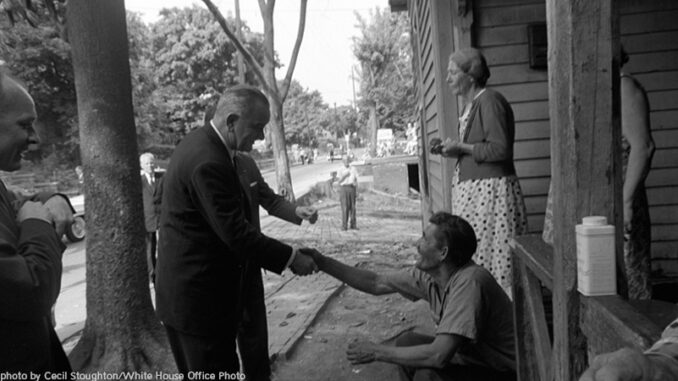
Solving the problem of poverty is a complicated issue as well as a continuing political hot-button topic in America. In 1964 then-president Lyndon B. Johnson made this issue a priority by declaring a “war on poverty” during his first State of the Union speech. On January 8th of this year, Johnson’s daughter, Lynda Johnson Robb, joined other distinguished guests in Washington, DC at a ceremony marking its 50th anniversary. Many are using the occasion as an opportunity to analyze the initiatives it launched and reflect on where we are now.

In the few years leading up to Johnson’s address, the number of adults not earning incomes sufficient to meet their needs was more than 20%. Johnson believed it was a war that “the richest nation on earth could afford to win.” Johnson biographers believe that this issue was important to the president because of his own history of growing up poor. He felt it was the country’s “moral obligation” to provide help people support themselves and contribute to society.
Johnson’s declaration led to the creation of the Office of Economic Opportunity in the Executive Office of the President, as well as several significant initiatives (often collectively called the Great Society) including:
- Economic Opportunity Act of 1964 – This piece of legislation created eleven major anti-poverty programs or agencies to provide education, training, grants, technical assistance, loans and incentives to those who qualified. Some of the most well-known programs are Head Start and the Volunteers in Service to America (VISTA), which eventually became AmeriCorps.
- Social Security Amendments of 1965 – This act created our country’s federally-funded health insurance for those over 65 (Medicare) and poor families (Medicaid). While Johnson signed the bill into law, discussions and negotiations began under President Harry Truman in the late 1940s.
- Food Stamp Act of 1964 – This federal aid program provides assistance to qualified persons to purchase food. There had been a program in place in 1939 but ended in 1943. It has been revised and amended many times beginning in 1977.
Looking Back and Moving Forward
Fifty years later, the debate over how best to deal with poverty still rages. Our political leaders remain deeply divided, as Republicans are generally concerned with opportunities for upward mobility while Democrats are generally focused on addressing issues of inequality. Both are looking at policies that contribute to income gap but can rarely agree on a common solution. In December, President Obama made a speech about the growing gap between the rich and the poor (called income inequality), calling it “the defining challenge of our time.” He called for an increase in the minimum wage, more affordable education and following through on the implementation of the Affordable Care Act (or Obamacare). Critics of the Obama Administration accuse him of promoting government-reliance instead of upward mobility.
The current poverty rate in the United States is 15% for the second straight year. The lowest rate in recent history was 11.3% in 2000, with its most recent high at 15.2% in 1982. The biggest change is the gap between the lowest and highest earners. Since 1967, the middle class has seen its earning grow 19% while the rich have seen an increase of 67%. Experts say that this kind of inequality is not a good sign of a stable economy.
